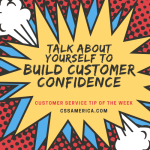
When we’re conducting web-based surveys for our clients, sometimes the respondent will bypass the survey and decide to send us an e-mail directly, or they’ll send us an e-mail in addition to the survey responses that they already provided online.
When we get these direct e-mails from the client’s customers, often they voice frustrations, and they either didn’t want to convey them through a survey, or they wanted to convey them in a way that emphasized their concerns. Sometimes they want us to rectify issues when they’re getting no direct solution from the company itself.
Whenever we receive these types of messages, we reply immediately. And every time we reply – regardless of their tone – we start by saying “Thank you,” and we end by saying “Thank you.”
It’s something that we emphasize when communicating with any customer, but it’s interesting that the mere statement of “Thank you” up front and the statement of “Thank you” in the end often changes how your message is received by the other person.
We frequently get follow-up e-mails from these irate customers, and they say “Thanks!” back to us for responding and getting the ball rolling. They apologize at times for dumping their frustrations on us. They change their tone in large part because we thank them for sharing their concerns with us.
Try this for a day or – even better – a week. EVERY TIME you talk to somebody on the phone, you respond to an e-mail, you see somebody face-to-face, start by thanking them for bringing something to your attention or for sending you the message. End by thanking them for what you learn from the conversation or for being willing to convey their message to you. This is not just for those irate customer situations. It is also for any conversation you have with a co-worker or customer.
It’s not as catchy as “ABC – Always be closing,” but “ABT – Always be thanking” can have a dramatic effect on others…and maybe even yourself.
By using the simple words “Thank you” at the start and by ending with “Thanks!”, your words can change their tone.
Use words to convey appreciation. See how the tone of conversations begins to change.
Signup for FREE Tips! Contact Us More Resources for You Visit Our Home Page























